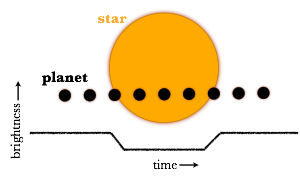Exoplanets
Exoplanets are the supposed planets which exist beyond the solar system. These planets are not visibly seen and cannot be resolved directly, but are discovered through indirect methods, such as slight overall brightness fluctuations of stars as seen over long time analysis through either earth-bound telescopes or alleged space-based telescopes.
Harvard University's terrestrial telescope array, the MEarth Project, explains (Archive):
“ Exoplanets are difficult to see directly from Earth. Because they are so small and faint, they are easily lost in the glare of the bright stars they orbit, so we often use indirect methods to find them. One of these is called the "transit method", where we carefully measure the brightness of a star over a long period of time, and look for periodic decreases in the brightness of a star that are caused by a planet passing in front of it. ”
“ Instead of detecting the planet, they infer its existence by observing the effects that it has on its parent star. Remember that both the star and the planet move around a common center of mass. These efforts take three major forms: Astrometric Methods look for the motion of the star (wobbles) about the center of mass....Radial Velocity Methods look for the periodic doppler shifts in the star's spectral lines as it moves about the center of mass.....Transit Methods look for the drop in the star's brightness as an exoplanet cuts across its disk along our line of sight. ”
Astronomers Baffled
Readers may read through the following articles and decide for themselves on the integrity of this science.
New Scientist - The weirdest stars we've ever seen have astronomers utterly baffled (Archive)
“ These may be the weirdest stars we’ve ever seen. A pair of stars about 360 light years away experienced 28 dips in their light over the course of 87 days, measurements that would normally indicate an orbiting system of planets – except that the timings of the dips seem totally random. Astronomers are completely stumped.
The stars, collectively called HD 139139, were spotted behaving strangely by the Kepler space telescope before it ran out of fuel and ceased observations. Kepler hunted exoplanets by watching for regular decreases in stars’ light caused by a planet passing between the star and the telescope on its orbit. These passes are called transits.
The dips in HD 139139’s light look just like transits, all similar in size and shape, but when Andrew Vanderburg at the University of Texas at Austin and his colleagues took a closer look at the data, they found that their timings seemed totally random – the researchers calculated that no more than four of the dips could be caused by the same orbiting object.
“We’ve been looking at stars with this kind of precision for about ten years now, but this is the first time that we’ve found something that looks like looks like a transiting planet but has no apparent periodicity,” says Hugh Osborn at the Laboratory of Astrophysics of Marseille in France. “Something weird is going on.”
If the transits are caused by planets, the researchers calculated that there would have to be lots of them, far more than any other planetary system we’ve ever seen. “I could construct for you a system of planets that would explain these dips, but it would be really contrived,” says Vanderburg. “It just doesn’t feel right.” And neither do any of the other explanations the team came up with.
One potential explanation was a disintegrating planet or disc of asteroids puffing out dust as they pass in front of the stars, which blocks out some light and then dissipates. But a disintegrating planet would still produce patterns in the transit timings, and the asteroids would have to all be emitting dust clouds of the same size and density, which is unlikely.
Sunspots and internal variations in the star’s light don’t quite work either, because they would have to appear and disappear in a matter of hours. The dark spots that we have seen on our own sun last from days to months, so this would require a new type of sunspot.
With all of the simple explanations ruled out, it’s tempting to consider that the light variations might be caused by a huge alien structure that has been constructed around the stars. We cannot definitively rule that out, but both Osborn and Vanderburg consider it highly unlikely.
“In astronomy we have a long history of not understanding something, thinking it’s aliens, and later finding out it’s something else,” says Vanderburg. “The odds are pretty good that it’s going to be another one of those.” ”
See Also
Giant planet discovered that shouldn’t even exist (Archive)
“ International research team baffled by massive gas planet because it’s not supposed to exist. ”
National Geographic - New Ultradense Planet Found; Astronomers Baffled (Archive)
“ CoRoT-20b is so compact it defies planet-formation theory, study says. ”
Most Ancient, 'Impossible' Alien Worlds Discovered (Archive)
“ Two worlds orbiting a "metal-poor" star probably existed when the Universe was less than a billion years old. ”
Astrophyscists puzzle over planet that's too close to its sun (Archive)
“ Scientists have discovered a planet that shouldn’t exist. ”
Nature - The triple sunset that should not exist (Archive)
“ You shouldn't see it, but you do see it. ”
Impossible Alien World is Impossible. Yet There It Is (Archive)
“ we just don't know. ”
https://www.universetoday.com/author/shannon-hall/page/12/
“ Most exoplanets are strikingly different from the planets in our own solar system. “We find planets in any order, at any distance, of any size; even planetary classes that don’t exist in the solar system,” Cabrera said. ”

